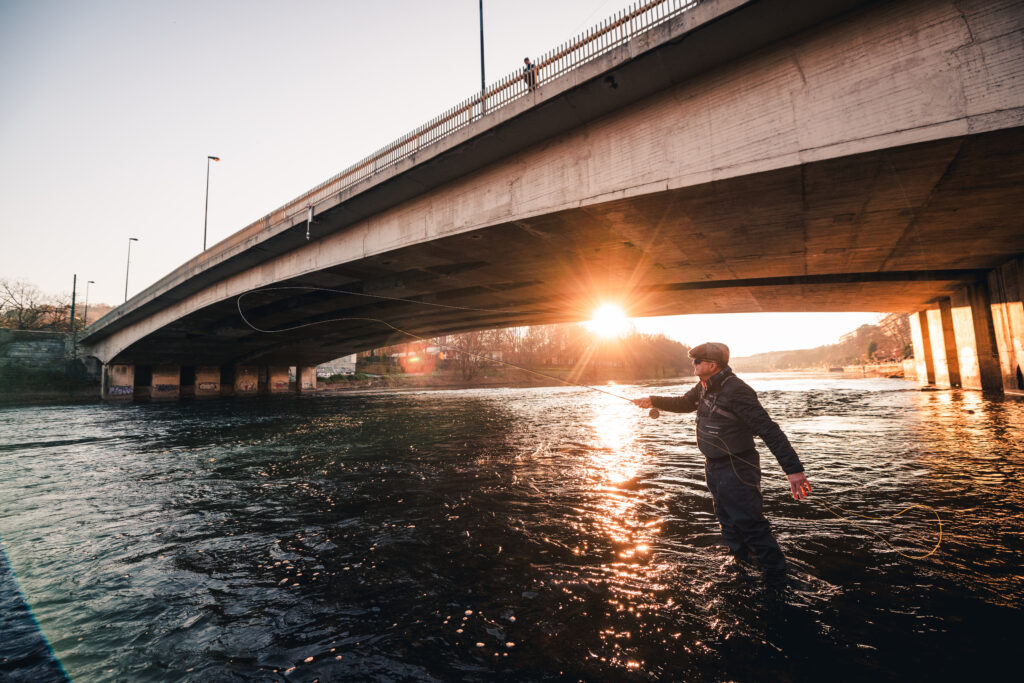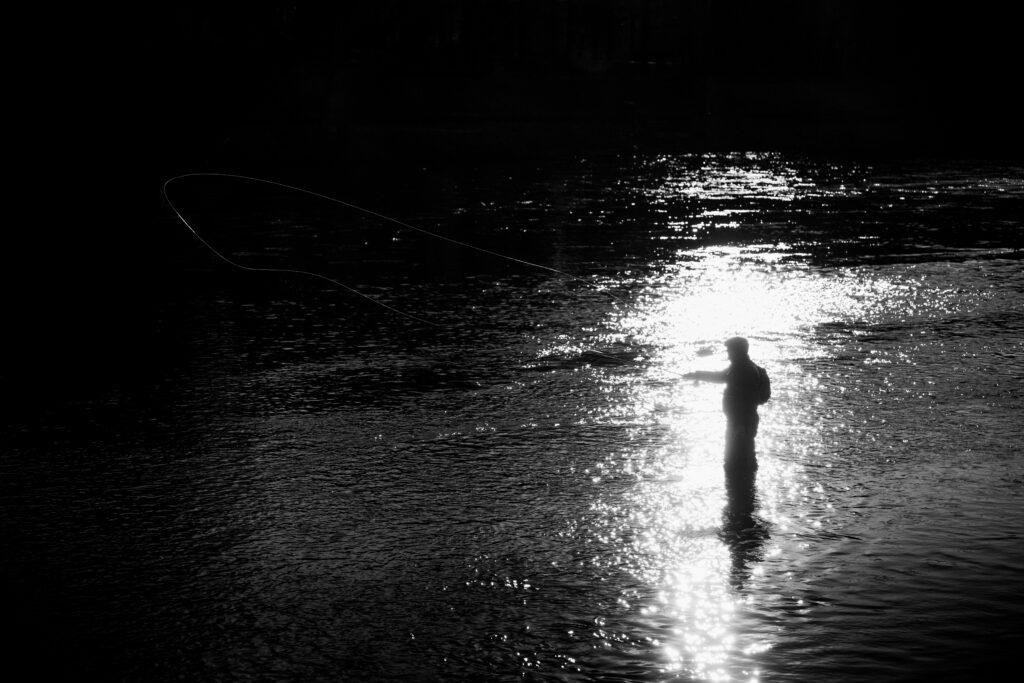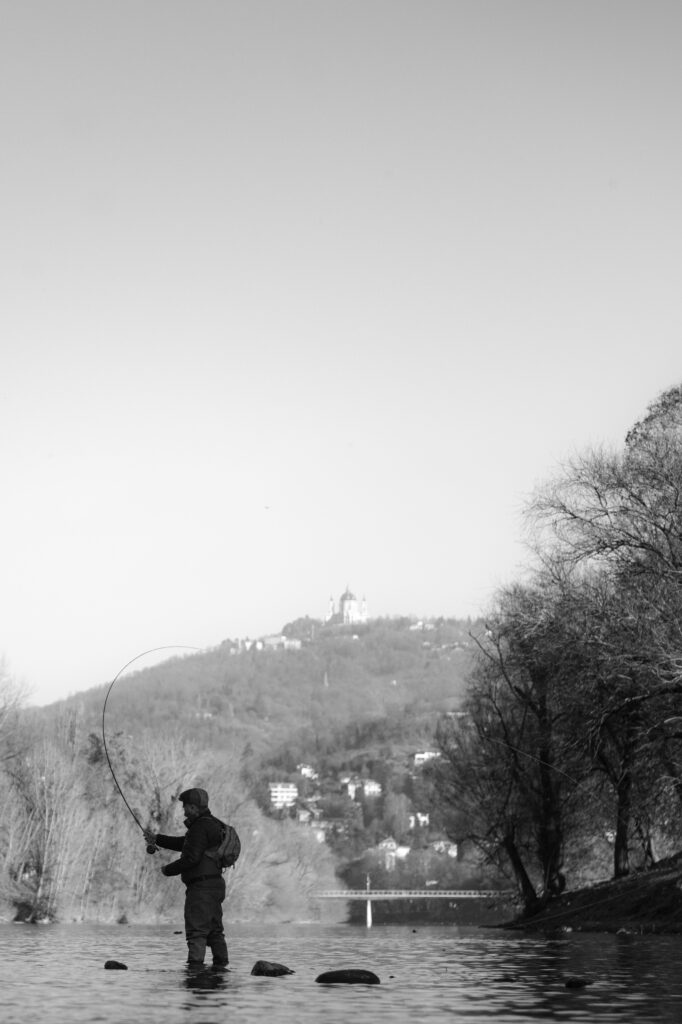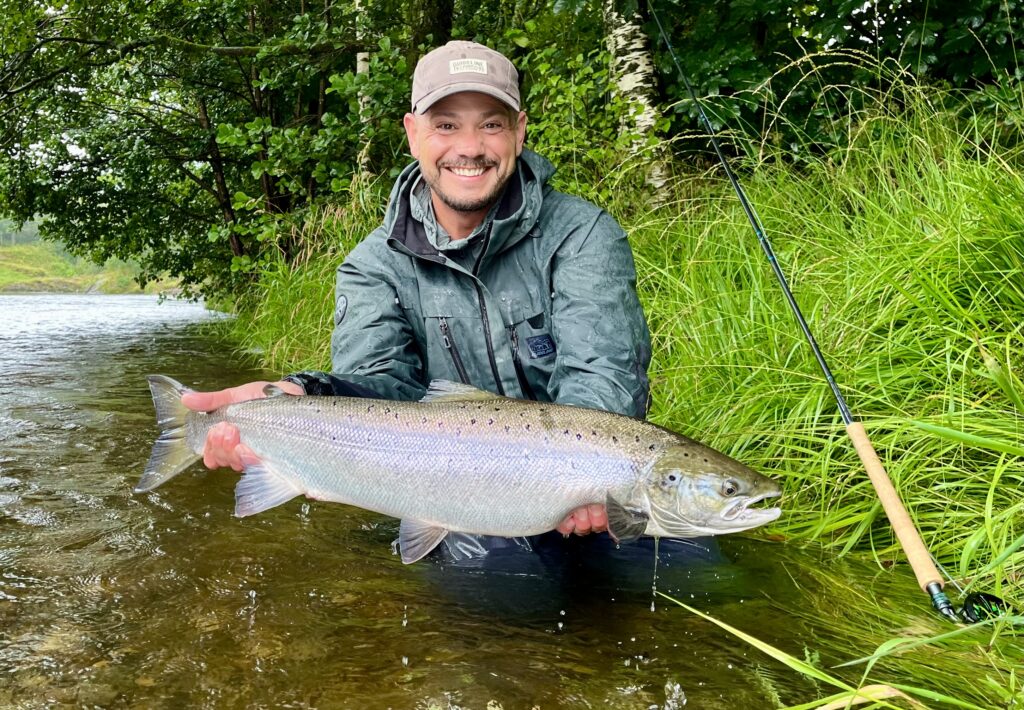Those who are lucky enough to have an adequate number of springs on their shoulders have certainly perceived a change in fishing and fly fishing in particular.
Fishing methods are gradually adapting to changing climactic conditions and the presence of invasive species such as cormorants and catfish in many of our European waterways, which have all significantly changed the feeding and ethological habits of the fish that inhabit them.
It is widely perceived that the periods in which fish feed on the surface have compressed and the poetry that animated the images described by Ernest Hemingway in “The River of Two Hearts” or by Norman McLean in his “A River Runs Through It”, is becoming progressively more evanescent.

This may be one of the reasons why many of us have enthusiastically welcomed the advent of casting and fishing with a two-handed rod, which has replaced the centrality of catching fish with the pleasure of the athletic gesture and the grace of the fly line that elegantly stretches in the air, before settling and – occasionally – giving us some nice fish that – as my Scottish friend Ally Gowans says – “unwelcomely interrupts a series of magnificent casts”.
That said, it is unquestionable that sometimes the use of a two-handed rod in medium-small sized rivers is disproportionate to the size of the watercourse or, equally, it is not a given that all fishermen are able to handle this tool in a functionalsatisfactory way.
Therefore, by applying the principles of Spey casting to the one-handed rod, you can obtain a perfect “swing effect“, even in smaller streams and rivers.

The only obstacle to this technique is that traditional WF lines are not exactly suitable (unless you go back to DT) and in this sense many American and European manufacturers have moved, studying new profiles that are much more performing.
Based on these considerations, we interviewed a well-known European caster – Tellis Katsogiannos who has collected an important series of victories in technical casting competitions and above all who is the creator of a series of fly lines dedicated to this type of casting.
Q/ First of all, tell us about yourself: who is Tellis Katsogiannos and what are his successes as a flycaster?
Born and raised in Gotheburg, Sweden by Swedish mother and Greek father. Ever since I was 3-4 years old, I have felt a huge connection to water and have been fishing all my life. In the middle of the 90s, I started tying flies and got my first fly fishing kit the Christmas of 1995. Catching fish or finding solutions to catch fish in tough conditions, has always been intriguing. This naturally led me to casting and the mechanics of casting. If I can’t get my fly to where the fish is, having the best fly in the world matters very little. I often found myself in situations where I need to find a way and a solution to be able to cast. Limited space, deep wading and so on. Understanding how the cast and mechanics work, you very quickly learn how to adapt to any given fishing situation and catch fish where other people don’t even bother to try. That feeling you get when you “defeat the situation” has always triggered me to try harder. This of course led me into Fly casting and tournament casting. As a former athlete in other sports this came rather natural to me, to have the discipline to train with focus, and still have an open mind towards other people’s knowledge and ideas. No one will ever reach the limit, as the limit is constantly pushed further away, just as any other sport. For me, winning the World Championship in 15´1 Spey casting in 2016 is my biggest accomplishment, followed by 2 silver and 1 bronze in 18´ Spey and a few World records over the years. In 2017 I also became a certified casting instructor and Master instructor for double hand with Fly Fishers International.
Q/ Given that you can never have too much fishing equipment, our arsenal of fly lines is already adequately stocked. What prompted you to design a new profile dedicated to the Spey technique with a one-handed rod?
As a nerdy fly angler and caster as well as product developer, I have always found and believed that the fly lines is hands down our most important tool. Many times, the lines abilities and density will have a higher importance than the fly. So, in my mind, you can never have too many fly lines! This specific line was launched already in 2012/2013, at that time with my own brand under the name Singlehand Spey. Later other big brands followed and more “specialist WF spey lines” for singlehand rods has come to the market. Joining Guideline as their new product developer in 2022, I was thrilled that they liked the idea of this line and it keeps living in form of Single Hand Scandi, which would be the “3.0” version of this line and taper. The idea of this line was initially, and still is, to create a WF line that can roll and spey cast like no other and to rather have limited overhead casting abilities, to further improve water anchored casting.

Q/ the profile seems very progressive and similar to the one that was introduced many years ago by the late Lee Wulff with his “triangle taper”. Is this feeling correct? If so, how is the series of lines you have designed different?
There is no doubt that Lee Wulff´s Tringle Taper was the stepping stone for the modern Spey line and is still considered a benchmark in many places. From his line, all modern Spey tapers has been born, adjusted and fine tuned for more specific tasks. The taper of this new line has the same principal idea, long taper with more weight/mass in the back portion of the line. But, as the name indicates, it has been fine tuned to be even more of a dedicated roll/spey casting line with a more distinctive weight concentration in the back. We have also fine tuned each single line weight in length, to create the most accurate and identical “weight to length ratio”, meaning that the head length on each model is different.
Q/ Do you think it is an “easy” line to cast, or does it require an expert caster?
In general, a very easy to cast line, especially for roll and spey casting with the full taper outside the rod tip. Most of the weight of the line will always be in the upper part of your D-loop (in the air behind the rod), giving you more room for bad anchorsanchor etc, without losing contact with the weight/mass of the lineof line. The only time this line will feel a bit difficult is if you are using larger flies and try to shootshot and cast with a verywith very short line. As mentioned, the majoritymajority of weight is in the back segment of the line, making it a bit tricky in the start, just as any other Spey line for DH rods.
Q/ what length of leader do you suggest using?
That depends on given fishing situation, size/weight of fly and so on. In general, I use about 12-15´ tapered leaders for the #4, #5 and #6 if I am fishing with dry flies, light nymphs and similar. As I use the #6 and up, I tend to shorten the leader as the flies is also getting bigger and heavier. The long front taper of this line can be a bit sensitive if your leader is too long in relation to size of fly and amount of head wind.
Q/ many anglers are used to Polyleaders to ensure that the fly reaches the right depth. Do lines with this profile allow you to use this type of leader? If so, with what characteristics? Which is the best Polyleader to be adopted?
The short answer is yes and no! If you tend to fish most of your time with heavier sinking poly leaders, you will find that the front of the line lacks the mass to turn over an additional added mass (poly leader). If you often want to fish with poly leaders, heavier flies or even very long leaders as mentioned earlier, I would strongly recommend customizing your line by cutting the front. For example, if you cut 1-1.5 meter from the front of the #6 or #7, you have barely lost 1-2 grams of the head weight, and as you have a continuous taper you will not “destroy your line” by doing so. You could even buy 1-2 heavier line weight and cut more, to create an even shorter more aggressive line. That’s what I have always lover about continuous tapers, it allows you to tweak the line to perfectly suit you and your fishing.
Q/ what are the applications that you think are most suitable for this type of line / equipment? Salmon and seatrout or trout, too?
As this line series is available from #4 to #8, it covers all types of fishing where water anchored cast is primarily needed. It started out as a streamer/salmon/sea trout line, but soon realized the huge benefits of having this type of lines for dry fly and presentation as well. The long and light front lands delicate and discrete and you could even use the #6 or #7 for spooky fish and dry flies, due to the light front.
Q/ I am convinced that rods do not always respond adequately and coherently to the line weight for which they are proposed and I suggest, if possible, to try the same rod with a line weight higher, equal and lower than the one required in order to identify the rod-line pairing that best suits the individual caster. Do you share this approach?
Well again, yes and no. If you understand the relationship between mass and force, you can cast any line on any rod. But there is also the fact that all of us regardless of skill level, will have a personal preference of the “perfect matchup”. What actually happens when we use a heavier line than recommended, it does in many ways compensate for our errors and in particular slack in the cast. The feeling of “emptiness” or inefficient “load”, is in most of the cases slack introduced to the line, giving us the feeling of an empty rod. So, if we have added more weight, we will have more mass to feel. As we get better at casting, slack will be minimized, timing is better, and our line tension is near perfect. This will in most cases mean that we want to REDUCE weight on the line. When we do water anchored casts, like Spey, we do in a way fold the line in half, casting and bending the rod against the line that is still in the air behind the rod (“upper part” of the D loop). That is the main reason why Spey lines have more weight in the back. We are casting against that amount of line, not the line on the water. That part is often referred to as “dead line”, whilst the line in the air is “alive”. When we make an overhead cast and the full head is straight in the air behind us, we cast and bend the rod against that full line length and weight, not in Spey. That is also the reason why it is many times more comfortable with more line weight when Spey casting, as the line again is “folded”.
Q/ Do the lines you studied also adapt well to switch rods?
Yes, this type of taper fit perfectly for Spey fishing with all types of rods, and this taper is specially designed for just that. However, it is important to mention that a majority of Switch rods today are DH rated, making the lines in this series to light as they are single hand rated. The more traditional switch rods are single hand rated that gives you the opportunity to do DH casting if needed, not the other way around as majority of switch rods are today.

Q/ Do you think it is possible to use lines with this profile also for traditional overhead casts?
Even if this type of taper and these lines in particular are designed mainly for water anchored casting, the back taper and special handling line gives you the opportunity to cast overhead as well. It will give a bit different feeling as a lot of the weight will be very close to the rod, but with some overhang the line cast wonderfully with aerial casts. (Photo: Alessandro Belluscio)
Conclusions.
In the transition from the one-handed rod to the two-handed, we appreciated the characteristics and potential of the Spey cast that allows us to fish for entire days with the swing technique which in turn has proven to be effective, efficient and not tiring.
The only flaw of this style or fishing philosophy lies in the fact that this technique is better suited to medium-large rivers and less to small watercourses, or to still waters, where the one-handed rod still has superior characteristics of handling and maneuverability. The missing link at this point is not a shorter two-handed rod (which requires much more expertise than the long rod to cast), but a different line, designed for this purpose.
Starting from the intuition of the late Lee Wulff with his continuous profile fly line, fly line manufacturers have studied and developed modern tools that allow us to exploit the versatility of the one-handed rod with the characteristics of the Spey cast and therefore allow us to have an excellent new fishing setup that ensures us fishermen can cast considerable distances in confined spaces and manage the line very effectively, just like the one-handed rod allows us.

Once you have learned the Spey cast and adapted it to the one-handed rod with the right line and setup, you can rediscover your entire arsenal of rods from eight feet up, reusing it in swing or dry fly technique as we like (or as the fish likes).
It’s worth a try. Word of a flyfisherman.

